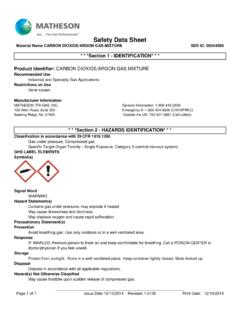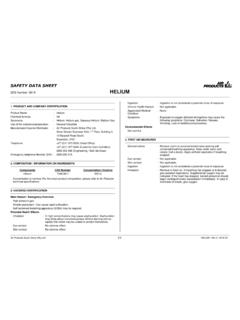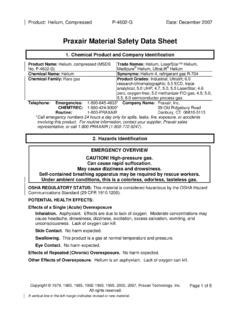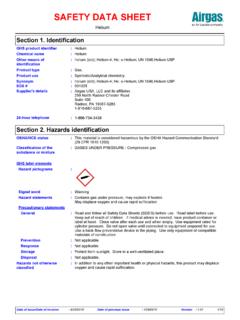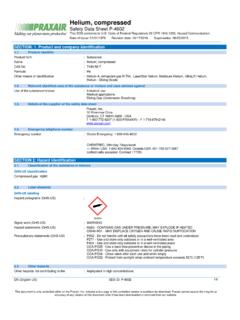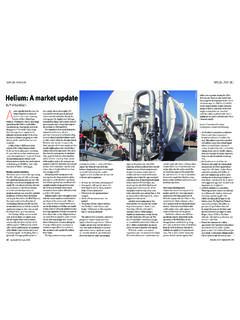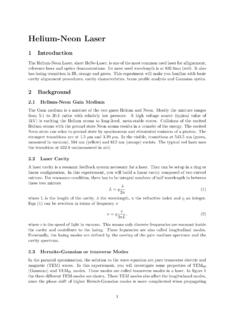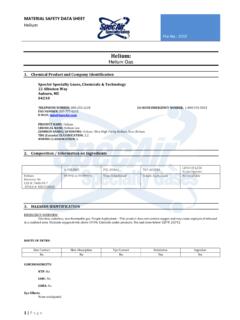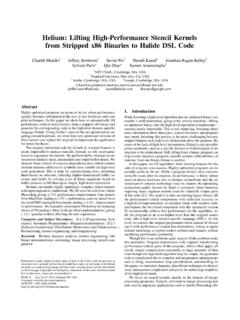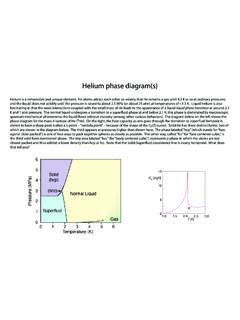Transcription of Material Safety Data Sheet - centralwelding.com
1 HELIUMHELIUMM aterial Safety Data SheetCommercial name(s).Section 1. Chemical product and company identification:10047 MSDS and general analytical or synthetic chemical : 1-800-424-93002700 Post Oak DriveHouston, TX 77056-8229 Emergency telephonenumberAddressTelephone MSDSINFORMATIONFax on Demand1-(800)-231-13661-(713)-896-2896 Product useManufactured/suppliedPrepared according to US OSHA, CMA, ANSI and Canadian WHMIS effects: Not classified or listed by IARC, NTP, OSHA, EU and effects: Not effects: Not Dermal contact. Eye 2. Hazards identificationRoutes of entryPotential acute health effectsInhalation of this product may cause dizziness, an irregular heartbeat, narcosis, nauseaor INHALED, OR ALLOW TO BE INHALED, EVEN FOR A SHORT PERIOD, helium CONTAINED IN A BALLOON, A GAS CONTAINER OR FILLINGEQUIPMENT.
2 INHALATION CAN CAUSE DEATH OR SEVERE known significant effects or critical the product is a gas, it will probably be inhaled rather than ingested. See known significant effects or critical toxicological information (section 11):::::::Potential chronic healtheffectsEmergency overview:CAUTION!HIGH PRESSURE GAS. GAS REDUCES OXYGEN AVAILABLE FOR away from heat (<52 C/125 F). Use only with adequate ventilation. Extremelyhazardous gas under pressure. Keep cylinder valve closed when the product is not may accumulate in confined signs/symptomsInhalationIngestionSkinEye sNo specific specific specific specific data.::::This Material is classified hazardous under OSHA regulations in the United States andthe WHMIS Controlled Product Regulation in conditionsaggravated by over-exposure:None status:Date of issue:12/31/2007 Page: 1/7 HELIUMS ection 3.
3 Composition, Information on IngredientsCanadaSee Sections 8, 11, 14 and 15 for numbermole %Chemical nameCAS # are no specific exposure limits for this gas is a simple asphyxiant (SA). Oxygenlevels should be maintained above %Occupational exposure limitsIDLHSee Section 16 for possible acronym definitionsUnited StatesNE: Not EstablishedC: Ceiling LimitSection 4. First aid measuresEye contactSkin contactInhalationIngestionNotes to physician:::::Prompt medical attention is mandatory in all cases of overexposure to this gas. Rescue personnel should wear aself-contained breathing medical doctor must be warned that the person may suffer from the product is a gas, it will probably be inhaled rather than ingested. See inhaled, remove to fresh air. If not breathing, give artificial respiration. Get medicalattention if symptoms specific an extinguishing agent suitable for the surrounding explosion may occur under fire conditions or when 5.
4 Fire fighting measuresFlammability of the productProducts of combustionExplosion hazards in thepresence of varioussubstancesFire-fighting media andinstructionsPromptly isolate the scene by removing all persons from the vicinity of the incident ifthere is a fire. No action shall be taken involving any personal risk or without suitabletraining. Contact supplier immediately for specialist advice. Move containers from firearea if this can be done without risk. Use water spray to keep fire-exposed gas under pressure. In a fire or if heated, a pressure increase will occur andthe container may burst or protectiveequipment for fire-fightersFire-fighters should wear appropriate protective equipment and self-contained breathingapparatus (SCBA) with a full face-piece operated in positive pressure mode.:::::EVACUATE ALL PERSONNEL FROM AFFECTED appropriate protective equipment.
5 If leak is in user's equipment, be certain to purgepiping with an inert gas prior to attempting repairs. If leak is on cylinder or cylinder valve,contact the closest Air Liquide 6. Accidental release measuresPersonal precautions:Date of issue:12/31/2007 Page: 2/7 HELIUMC ontact your local Air Liquide Gas supplier for precautions:In case of a leak, clear the affected area, protect people, eliminate sources of ignitionand respond with trained leaking incidentally from the cylinder or its valve, contact your supplier. Use non-sparking tools and equipment during the for cleaning up:Protect cylinders from physical damage. Store in cool, dry, well-ventilated area of noncombustible construction away from heavy traffic areas and emergency exits. Do notallow the temperature where cylinders are stored to exceed 52 C/125 F.
6 Cylinders mustbe stored upright and firmly secured to prevent falling or being knocked over. Full andempty cylinders should be segregated. Prevent full cylinders being stored for excessiveperiods of time. Post "No Smoking or Open Flames" signs in the storage or use should be no source of ignition in the storage or use protection caps must remain in place unless cylinder is secured with valve outletpiped to usage point. Do not drag, slide or roll cylinders. Use a suitable hand truck forcylinder movement. Use a pressure regulator when connecting cylinder to lowerpressure piping or systems. Do not heat cylinder by any means to increase the dischargerate of product from the cylinder. Use a check valve or trap in the discharge line toprevent hazardous back flow to the cylinder. Do not tamper with (valve) Safety valve after each use and when 7.
7 Handling and storageHandlingStorage::Use only in well-ventilated 8. Exposure controls/personal protectionEngineering controlsMaintain oxygen levels above in the workplace. Use supplied air respiratoryprotection if oxygen levels are below (air purifying respirators will not function) orduring emergency response to a release of this gas. During an emergency situation,before entering the area, check for oxygen-deficient atmospheres. If respiratoryprotection is required, follow the requirements of the Federal OSHA RespiratoryProtection Standard (29 CFR ), or equivalent State glasses with side body protection appropriate for task. Cotton clothing is recommended for use toprevent static electric build-up. Pressurized product may require use of fire protectionEyesSkin/BodyRespiratory::::Pe rsonal protection in caseof a major leak:Wear leather gloves when handling cylinders of this gas.
8 Otherwise, wear gloveprotection appropriate to the specific operation for which this gas is : Safety glasses with side shields, goggles or face shield. Impervious gloves. Protectiveclothing. Metal cap, Safety shoes. Wear MSHA/NIOSH-approved self-containedbreathing apparatus or equivalent and full protective applications of this product may require additionnal or other specific protective clothings. Please consultyour cap, Safety shoes are recommended when handling of issue:12/31/2007 Page: 3/7 HELIUMP roduct nameExposure limitsHeliumSimple asphyxiant. (NE)CanadaUnited StatesHeliumSimple asphyxiant. (NE)NE: Not C (-452 F) C (-458 F) (Air = 1) [Air = 1]4 pointMelting/freezing pointSection 9. Physical and chemical propertiesPhysical stateMolecular weightSpecific gravityVapor densityOdorColorHeMolecular formula:::::::::The product is normal conditions of storage and use, hazardous polymerization will not normal conditions of storage and use, hazardous decomposition products shouldnot be 10.
9 Stability and reactivityStability and reactivityHazardous decompositionproductsHazardous polymerization:::Section 11. Toxicological informationEyes:No known significant effects or critical :No known significant effects or critical :Inhalation of this product may cause dizziness, an irregular heartbeat, narcosis, nauseaor INHALED, OR ALLOW TO BE INHALED, EVEN FOR A SHORT PERIOD, helium CONTAINED IN A BALLOON, A GAS CONTAINER OR FILLINGEQUIPMENT. INHALATION CAN CAUSE DEATH OR SEVERE :Since the product is a gas, it will probably be inhaled rather than ingested. See EffectsPotential chronic healtheffects:Carcinogenic effects: Not classified or listed by IARC, NTP, OSHA, EU and effects: Not effects: Not gas is released as is in the 12. Ecological informationProducts of degradation:DisposalSection 13. Disposal considerations:Residual materials contained in customer-owned cylinders should be disposed of inaccordance with Federal, State and Local regulations on waste management.
10 Forresidual materials contained in cylinders owned by Air Liquide, contact Sales orCustomer Service to determine appropriate disposal. Do not return cylinders withoutauthorization from Air of issue:12/31/2007 Page: 4/7 HELIUMT ransport information14 . instructionPassenger aircraftQuantity limitation: 75 kgCargo aircraftQuantity limitation: 150kg2 NON- FLAMMABLE GASDOT ClassificationTDG , COMPRESSED-UN1046 helium , COMPRESSED-UN numberProper shipping nameClassPGLabelUN1046-UN / IMDG / IATAC lassificationUN1046 helium , and CargoAircraftQuantity limitation:75 kgCargo Aircraft OnlyQuantity limitation: 150 kgIATA-Cylinders should be transported in a secure position, in a well ventilated vehicle. The transportation of compressed gascylinders in automobiles or in closed-body vehicles can present serious Safety hazards and should be 15.
